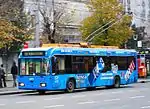Trolleybuses in Belgrade
The Belgrade trolleybus system forms part of the public transportation network in the city of Belgrade, the capital of Serbia. It is operated by the city-owned public transportation company GSP Belgrade. In 2017, the network consisted of 7 lines, with 125 trolleybuses operating on 55.8 km (34.7 mi) of two-way overhead wires.[1] Trola, Serbian name for the trolley pole, became among Belgraders the common, colloquial name for the trolleybus in general.
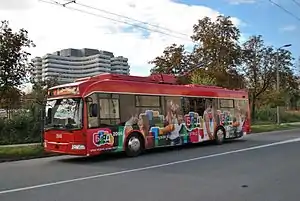 AKSM-321 in Banjica, in front of the Military Medical Academy | |
| Overview | |
|---|---|
| Owner | GSP Belgrade |
| Locale | |
| Transit type | Trolleybus |
| Number of lines | 7 (daytime) |
| Website | GSP (in Serbian) |
| Operation | |
| Began operation | 22 June 1947 |
| Operator(s) | GSP Belgrade |
| Technical | |
| System length | Line length: 55.8 km (34.7 mi) |
| Electrification | 600 V DC |
History
Background
The idea of introducing trolleybuses was considered during Interbellum. In the late 1930s, city's Directory for trams and lights prepared the acquisition of the first vehicles. The intention was to introduce the trolleybus lines which would connect the downtown Belgrade to Karaburma. World War II prevented the realization of this plan but the devastation of the tram infrastructure during the war revitalized the idea of trolleybuses.[2]
1947-1960s expansion
The first trolleybus was presented to the public during the Labor Day parade on 1 May 1947 while the network became operational on 22 June 1947. First two lines were Kalemegdan-Slavija and Crveni Krst-Slavija, which was later expanded to Kalemegdan Park, too. Several months later, the third line, to Dušanovac, was open. In the 1950s, the general idea was that trolleybuses should take over the major role in the public transportation. By 1955, the number of trolleybuses rose to 42. Envisioned plans included lines to Zemun, Karaburma, New Belgrade and Dedinje, but not all were carried into effect. Line to Zemun was opened in 1956, and in time three lines across the Sava river were formed: Line 14 – Zeleni Venac-Gornji Grad (Zemun) (which was considered a successor line to the pre-war tram line), Line 15 – Zeleni Venac-Novi Grad (Zemun) and Line 16 – Zeleni Venac-Pohorska, New Belgrade.[2]
During this period, trolleybus became part of the Belgrade's sub-culture due to the activity of kešanje (slang for hanging onto something). Instead of entering the vehicle and paying for the ticket, the teenagers and young adults would grab onto the trolley pole on the outside.
1970s decline
Since the late 1960s, city authorities began to consider abolishing the trolleybus network completely. In 1973 all three lines across the river were terminated and by the ending of Branko Pešić’s tenure as the mayor of Belgrade in 1974, only one line survived, Kalemegdan-Kruševačka, Lekino Brdo. It was planned for it to be abolished, too, but already in the mid-1970s, after several types of research, city government changed the opinion and began developing the trolleybus network again.[2]
1980s revitalization
By the early 1980s, new neighborhoods planned to become part of the network were Konjarnik, Miljakovac, Učiteljsko Naselje, Medaković, Banjica, Kumodraž, and Zvezdara. By 1982 trolleybuses reached Konjarnik (Line 19) and Učiteljsko Naselje (Line 21) and the Line 28, connecting Kalemegdan to Zvezdara opened in 1983. In 1985 Line 41 connected Kalemegdan to Banjica II and in 1986 Line 40 was opened between Banjica II and Zvezdara. By the late 1980s, citizens became accustomed to the network and in the 1990s a new trolleybus depot was built in Dorćol, with the capacity of servicing 135 vehicles.[2]
Future
After new city government took over in 2013, an idea of abolishing the trolleybus network was raised again, partially prompted by the experimental introduction of the electric buses. Due to the possible creation of the pedestrian zone in the entire central section of Belgrade, propositions include the change of the routes in downtown, the relocation of the central terminus from Studentski Trg to Slavija and of the depo from Dorćol to Medaković. The remaining lines should connect the hilly parts of the city: Konjarnik, Medaković, Vračar, Banjica and Kanarevo Brdo.[2] City manager Goran Vesić announced that one single tram line will replace all four trolleybus lines (19, 21, 22 and 29) and the only bus line (31), which traverse through the city's main street Kralja Milana. Regarding reasons, Vesić stated that the overhead lines look ugly in downtown and that citizen complained about the noise made by the trolleybuses. The immediate reaction of the citizens was mostly negative.[3][4]
However, some of the advantages of the trolleybuses are their minimal noise pollution. Also, there is a matter of price of digging up the entire center of the city so that at least 6 km (3.7 mi) of tram tracks can be placed, and the cost of buying the new trams which will supposedly be operated on capacitors, without the grid. At the moment, five lines pass through the main street 47 times per hour.[5] On average, that is one vehicle on every 86 second, which is virtually impossible with only one line. In May 2017, Prime Minister of Serbia Aleksandar Vučić, even though the Belgrade's city transportation is completely outside of his jurisdiction, stated that he wants to abolish the trolleybus network completely and replace it with the electric buses. As a reason, he said that the trolleybuses are causing problems and that when one stops due to the malfunction, it stops the entire traffic behind it.[6] Though electric buses may be a better solution than the trams, Vučić's reasoning is dubious, just like the Vesić's. Trolleybus has easier traffic avoidance than a tram. Contrary to the trams, which indeed stops all the trams behind when one malfunction because they all use the same tracks when a trolleybus is broken, it is simply unhooked from the grid and is easily bypassed by the trolleybus behind it.
After public protests, the 2013 idea was modified in 2015 and the city announced that the terminus from Studentski Trg will be relocated to the Dunavska Street, extending the trolleybus lines to Dorćol, as a temporary solution. As of July 2019 nothing has been done regarding the trolleybuses relocation. Due to the massive 2018-2019 reconstruction of the Republic Square, some lines were shortened only to the Slavija quare, some were replaced with buses, while some were abolished completely. After continued citizens protests, city administration modified its idea of the large pedestrian zone in downtown and announced that all trolleybuses will be returned to their regular lines in September 2019, after the reconstruction of the square is finished.[7] However, after the square was reopened for traffic on 1 November 2019, lines 21 and 22 remained shortened to the Slavija Square, while lines 19 and 28 were completely abolished due to the "overlapping in the central city zone".[8][9] But it was also reported that the reduction (it also included several bus lines) is part of the ongoing plan by the city to transform the main traffic route into the pedestrian zone and because of the weight restrictions due to the botched reconstruction of the Republic Square.[10]
In December 2018, Ministry of construction, transportation and infrastructure instigated changes in the Law on Communal Activity, which would allow for private companies to operate trams and trolleybuses, as the present law allows them only to operate city transportation's bus lines. However, deputy mayor Vesić said that city will buy 80 electric buses instead and that trolleybus lines will be shut completely.[11] In October 2019, a scandal broke out when it was reported that some 80 trolleybuses (64%) are not registered (which was discovered by the police in the spring of 2019). GSP general manager was charged, though the company claimed that vehicles have regular technical inspections.[12]
Dorćol route
As the city authorities continued with their already heavily criticized project of removing the traffic completely from downtown and conducting it into the neighborhood of Dorćol, they began the construction of the grid. Local residents opposed the idea and blocked the streets. When city sent workers to begin the works on the new grid, the residents physically prevented them. They are opposing the project which will reduce the sidewalks and number of parking spots, cut the trees and induce further traffic jams. City claimed they are doing this because of the wishes of the citizens but never provided any proof of that. After negotiations with the residents, city decided to temporarily halt the works and later announced the partial change of the route.[13][14][15][16][17][18]
In March 2020, due to the COVID-19 pandemic, a state of emergency was declared in Serbia, which included social distancing, partial curfew and ban on public gathering. The emergency was declared on 16 March and already on 17 March city began to cut trees to make way for the grid. Citizens reported that the city is building the route as they like, pushing aside what little agreement they made with the citizens, that workers employed in the construction don't follow protocolos of protection during the pandemic and that works are being done without all necessary permits since there was no time to obtain them so fast. City responded that now, when there is no traffic, it is ideal time to work and that they do everything as agreed with the citizens who are now legally prevented to organize protests and blockades due to the state of emergency.[19] The works continued only during the night curfew, including loud construction works like the hydraulic concrete drilling. Police refused to intervene so the situation culminated in late April when citizens gathered in the streets, breaking the curfew and halting the works. Police then appeared with black Marias but an ad hoc agreement was reached by which residents returned to their homes, and the works were stopped.[20][21]
Line 28
City Hospital (today KBC Zvezdara) was opened on 1 December 1935. In the early 1941, before World War II began in Yugoslavia, the bus Line 28 was established, which connected City Hospital to Theatre Square in downtown Belgrade, via Hadžipopovac and Profesorska Kolonija. The line was kept operational by the German occupational authorities throughout the war, from 1941 to 1944. After the war, the bus line of the similar route continued, but was renamed to Line 27. In 1949, the pre-war line was fully re-established, and the number 28 was returned.[22]
The buses which operated on the line were Miesse and Renault. Later bus brands on the line included Leyland Royal Tiger Worldmaster, MAN and Ikarbus. The buses were replaced by trolleybuses in 1983, but neither the number nor the route changed (modern street names): Dimitrija Tucovića-Cvijićeva-Jaše Prodanovića-Takovska-Svetogorska-Makedonska-Republic Square-Vasina-Studentski Trg.[22]
The changes in 2019, especially the shut down of the line 28 was described as the "complete miss" and caused public protests and gatherings, and street and works blockades. Thousands of people signed petition asking for the line to be restored and organized protests along the line's route.[23] Closing and shortening of the lines in November 2019 right away resulted in crowds in the surviving lines and massive public discontent. Especially affected was Zvezdara municipality as lines 19, 21 and 28 were connecting different parts of Zvezdara to downtown. Furthermore, line 28 was the only line of public transportation which connected downtown to KBC Zvezdara, one of the largest medical-hospital complexes in Belgrade. Authorities said that everything is covered with changing buses on other lines, but it turned out that for some, previously direct routes, it takes an extra hour for the commuters. Another explanation by the authorities was reduced pollution in downtown. However, an extra diesel-operated bus line No. 22A, for the shortened section of the trolleybus lines through the city center, was introduced. Just five days into new network, mayor Zoran Radojičić said that line 28 "may be reintroduced".[24][25][26] The residents continued to occasionally block the traffic and in February 2020 they placed a "monument" to line 28 at its former terminus at Studentski Trg.[27]
The line was also directly connecting several students' dormitories to the Belgrade University. The abolishment and shortening of the lines was abrupt and unannounced. In the 2015 project, line 28 was not only preserved, but was planned for extension - to Medaković III on one, and to Cerak Vinogradi, on the other side. When the reconstruction of the Republic Square began, it was stated that the shutting of the lines was temporary. And when the works were finished on 1 September 2019, all the lines were indeed restored. However, when two weeks later the newly renovated square began to fall apart, the cubes which were used for paving were turned upside down. After this was finished, the lines were shut down, unofficially, because of the mishandled reconstruction and poor quality.[28]
After 4 months of protests, city finally accepted to hold talks with the citizens regarding line 28 in the late February 2020.[29] Previously they completely ignored the protesters, not answering to any petition or question, refusing to disclose the study on which they based the abolishment of the line, even when they had to do it when the Law on Free Access to Information was invoked by the activists.[30] After several sessions city remained insistent on enforcing pedestrian zone in the entire downtown and refusing to re-establish the line. The activists said they will physically prevent removal of the electric grid.[28][31] In June 2020, city administration announced restoration of the line for 6 July, after the study of Transportation Faculty which showed that the restoration of the line is justified.[32][33]
Lines
As of 2017, there are seven lines in operation. They operate every day, on a different timetable, depending on the time of the day or if it is a weekend. There are no night trolleybus lines.
| Number | Route (Neighborhoods) |
|---|---|
| 19[lower-alpha 1] | Studentski Trg – Republic Square – Terazije – London – Slavija – Čubura – Crveni Krst – Šumice – Denkova Bašta – Konjarnik |
| 21[lower-alpha 1] | Studentski Trg – Republic Square – Terazije – London – Slavija – Čubura – Crveni Krst – Šumice – Denkova Bašta – Učiteljsko Naselje |
| 22[lower-alpha 1] | Studentski Trg – Republic Square – Terazije – London – Slavija – Čubura – Crveni Krst – Pašino Brdo – Kruševačka street |
| 28[lower-alpha 1] | Studentski Trg – Republic Square – Stari Grad – Palilula – Hadžipopovac – Bulbulder – Zvezdara |
| 29 | Studentski Trg – Republic Square – Terazije – London – Slavija – Čubura – Crveni Krst – Šumice – Denkova Bašta – Konjarnik – Medaković II – Padina – Medaković III |
| 40 | Zvezdara – Bulbuder – Hadžipopovac – Palilula – Andrićev Venac – London – Savski Venac – Zapadni Vračar – Mostar – Senjak – Prokop – Dedinje – Banjica – Banjica II |
| 41 | Studentski Trg – Republic Square – Stari Grad – Andrićev Venac – London – Savski Venac – Zapadni Vračar – Mostar – Senjak – Prokop – Dedinje – Banjica – Banjica II |
Some of the recently abolished lines include Line 22L, which operated from Kalemegdan to Slavija, as the shortest line of the public transportation in Belgrade (2.5 km (1.6 mi)) which was abolished on 3 September 2012, and Line 29N, night line which was abolished in 2006 and replaced by the bus.
The fleet
In 2012, when the fleet numbered 133 vehicles, the breakdown by the type was:
- AKSM-321 – 93 vehicles
- AKSM-333 – 12 vehicles
- TrolZa-62052.01 – 12 vehicles
- AKSM-201 – 10 vehicles
- ZiU-9 – 4 vehicles
- VMZ-5298.00 – 1 vehicle
- TrolZa-5275.05 Optima – 1 vehicle
3 Hess/Kiepe lighTram buses will be delivered in June 2019.
Former types included:
- FIAT 668F – 31 vehicles (introduced in 1947)
- Alfa Romeo 140AF – 12 vehicles (1949)
- Goša I – 40 vehicles (1956) (domestic production)
- Goša II – 38 vehicles (1957–58) (domestic production)
- FAGES 63 – 60 vehicles (1964–65) (domestic production)
- Gräf & Stift GE 112 M 16 – 3 vehicles (2003) (donation by the city of Salzburg)
- Gräf & Stift GOE 112 M 11 – 2 vehicles (2003) (donation by the city of Salzburg)
Photos
|
See also
References
- "GSP Beograd – statistika" (in Serbian). GSP Beograd. 2016.
- Dejan Aleksić (2 May 2017), ""Trole" vozile Novobeograđane i Zemunce", Politika (in Serbian), p. 31
- FoNet (26 November 2016), "Ponovo tramvaj od Slavije preko Terazija do Kalemegdana", N1 (in Serbian)
- Dejan Aleksić (4 December 2016), "I "za" i "protiv" vraćanja "jedinice" u centar", Politika (in Serbian)
- Dejan Aleksić (20 December 2016), "Širenje tramvajske mreže ne ometa gradnju metroa", Politika (in Serbian)
- Tanjug (14 May 2017), "Vučić: Da ukinemo trolejbuse, prave nam problem", B92 (in Serbian)
- Dejan Aleksić (18 July 2019). Троле се од септембра враћају на Студентски трг [Trolleybuses are returning to the Studentski Trg in September]. Politika (in Serbian). p. 15.
- Beoinfo (1 November 2019). "Svi autobusi se vraćaju na Trg Republike, a od trolejbusa samo 29 i 41" [All bus lines return to Republic Square, but of trolleybus lines, only No. 29 and No. 41] (in Serbian). N1.
- Информација о завршетку радова на Тргу републике [Information on the finished works on Republic Square] (PDF) (in Serbian). GSP. 1 November 2019.
- Dejan Aleksić (5 November 2019). "Ukidanje trolejbusa "preko kolena" i gnev građana" [Forces shutting down trolleybuses and citizens' anger]. Politika (in Serbian). p. 15.
- S.B. Milošević (2 December 2018). "Po hitnom postupku: Šine u BG i privatnicima, trolejbusi u istoriju" [Accelerated procedure: tram tracks in Belgrade go to private companies, trolleybuses go to history] (in Serbian). Večernje Novosti, B92.
- Dejan Aleksić (26 October 2019). Тролејбуси нерегистровани, пријаве против директора ГСП-а [Trolleybuses not registered, charges against GPS manager]. Politika (in Serbian).
- Beta (23 November 2019). "NDM BGD: Blokirana izgradnja trase trolejbusa od Cvijićeve do Dunavske ulice" [Ne Davimo Beograd: construction of the trolleybus line from Cvijićeva to Dunavska Street blocked] (in Serbian). N1.
- Marko Bastać [@bastacbastac] (23 November 2019). "Stanari Dorćola zaustavili su radnike..." [Residents of Dorćol prevented the workers...] (Tweet) (in Serbian) – via Twitter.
- Dušica Jovanović (26 November 2019). "Stanari Donjeg Dorćola traže mišljenje stručnjaka o premeštanju trolejbusa" [Residents of Lower Dorćola ask for opinions on displacement of the trolleybuses from experts] (in Serbian). N1.
- Marko Bastać [@bastacbastac] (27 November 2019). "Niko ih ništa nije pitao! Niko ih ni o čemu nije obavestio!" [No one asked them anything! No one notified them of anything!] (Tweet) (in Serbian) – via Twitter.
- Dejan Aleksić (27 November 2019). "Žitelji Donjeg Dorćola protiv trolejbusa" [Resident of Lower Dorćol against trolleybuses]. Politika (in Serbian). p. 14.
- Dejan Aleksić (29 November 2019). "Moguća izmena projekta trolejbuske mreže na Dorćolu" [Possible changes of the Dorćol's trolleybus grid project]. Politika (in Serbian). p. 15.
- Dejan Aleksić (9 April 2020). "Radovi na mreži trolejbusa uznemirili Donji Dorćol" [Works on the trolleybus grid in Lower Dorćol]. Politika (in Serbian). p. 17.
- Direktno.rs (28 April 2020). "Dorćolci sinoć izašli na ulicu" [Dorćol residents came out to the streets last night]. Direktno (in Serbian).
- Ne Davimo Beograd - NDMBGD [@nedavimobgd] (27 April 2020). "Dok je trajao protest..." [While the protest lasted...] (Tweet) (in Serbian) – via Twitter.
- Branko Bogdanović (23 February 2020). Политикин времеплов - Булбулдерски тролејбус [The Bulbulder trolleybus]. Politika-Magazin, No. 1169 (in Serbian). pp. 28–29.
- Milan Janković (25 November 2019). Од један до пет - Тролејбус 28 [1 to 5 - Trolleybus 28]. Politika (in Serbian). p. 13.
- Milan Janković (4 November 2019). Од један до пет: Укидање тролејбуса [1 to 5: shutting down the trolleybuses]. Politika (in Serbian). p. 14.
- Beta, FoNet (5 November 2019). "Šumarac: Gradskoj vlasti važnije kocke od građana Zvezdare" [Šumarac: Slabs more important to the government that residents of Zvezdara] (in Serbian). N1.
- Beta (5 November 2019). "Radojičić: Linija 28 će biti vraćena ukoliko bude bilo potrebe" [Radojičić: Line 28 will be reintroduced if there is a need for it] (in Serbian). N1.
- Aleksandra Kurteš (19 February 2020). "Otkriven spomenik trolejbusu 28" [A monument to trolleybus 28 unveiled]. Politika (in Serbian). p. 16.
- Dejan Aleksić (3 March 2020). И даље без повратка тролејбуса 28 [Still no return of trolleybus 28]. Politika (in Serbian). p. 14.
- Dejan Aleksić (27 February 2020). Иницијатива "Вратимо тролу 28" позвана на састанак [Initiative "Return trollezbus 28" called on a meeting]. Politika (in Serbian). p. 16.
- Milan Janković (2 March 2020). Од један до пет - Тролејбус 28 [1 to 5 - Trolleybus 28]. Politika (in Serbian). p. 14.
- Dejan Aleksić (4 March 2020). Ускоро нови састанак за враћање "двадесет осмице" [Soon new meeting regarding the return of "twenty eight"]. Politika (in Serbian). p. 14.
- Dejan Aleksić (30 June 2020). Тролејбус 28 биће враћен на стару трасу [Trolleybus 28 will be returned to its old route]. Politika (in Serbian). p. 15.
- Dejan Aleksić (7 July 2020). "Vratila se "dvadesetosmica"" ["Twenty-eight" returned]. Politika (in Serbian). p. 15.
Notes
Notes:
- Since 2016, city administration began experimenting with public transportation lines, including trolleybuses. On 1 November 2019 lines 21 and 22 were shortened to Slavija Square, while lines 19 and 28 were completely abolished. Since city regularly change routes, abolishes then recreates same routes, it is not known for sure if this is the final decision
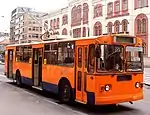
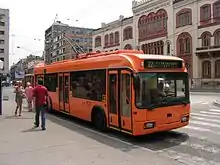
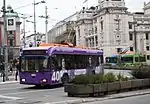
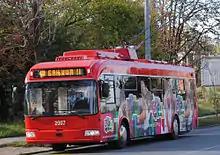

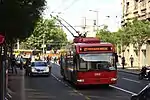
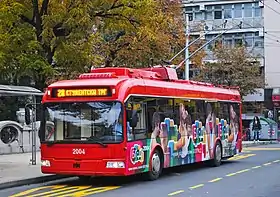


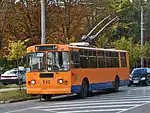
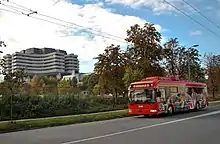
.JPG.webp)


